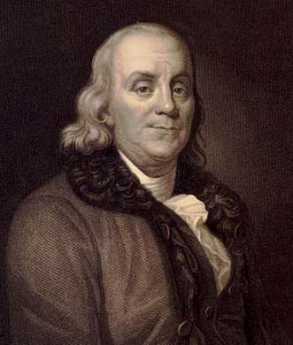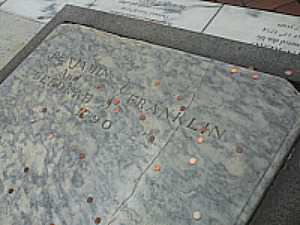Related Topics
Benjamin Franklin
A collection of Benjamin Franklin tidbits that relate Philadelphia's revolutionary prelate to his moving around the city, the colonies, and the world.

Philadelphia, A Running Commentary
A series of observations in and around Philadelphia by notables over the last three and one-half centuries.

Franklin's Funeral, 1790

|
| Benjamin Franklin's Grave |
"Philadelphia's silver decade began with the death of Benjamin Franklin, at the age of eighty-four, in 1790. On April 21, some 20,000 people, nearly half the city, lined the route of Franklin's funeral procession from the State House to the Christ Church burying ground. The procession was led by the clergy of the city, and the coffin was carried by six pallbearers:General Thomas Mifflin<, president of Pennsylvania; Thomas McKean, chief justice; Samuel Powell, mayor of Philadelphia; Thomas Willing, president of the Bank of North America; David Rittenhouse, professor of astronomy at the College of Philadelphia; and William Bingham, the richest man in America, member of the Pennsylvania Assembly, and soon to be appointed United States senator from the state. There followed the family and close friends, members of the state Assembly, judges of the State Supreme Court, gentlemen of the bar, printers with their journeymen and apprentices, and members of the Philosophical Society and a host of other associations that Franklin had founded. Doctor Rush sent a lock of Franklin's hair to the Marquis de Lafayette, and when the news reached France, the National Assembly heard a eulogy on the "sage of two worlds" by Mirabeau and sent a letter of sympathy to its sister Republic."
--E. Digby Baltzell, Puritan Boston and Quaker Philadelphia
Those who have experience with arranging state funerals will notice the strong Pennsylvania character of the funeral, and the subdued prominence of national figures, especially those from Virginia, Massachusetts, and New York. Some historians have noticed this anomaly, even surmising that Washington and others were jealous of Franklin's fame. However, the Capital was in New York City until August 12, 1790, and did not move to Philadelphia until December 6, 1790. Under the circumstances, it might have been difficult even to be certain the news of his death on April 17 had reached all the national leaders by April 21, let alone orchestrate arrangements of the funeral ceremonies around their uncertain presence at it.
Furthermore, he had a long life, from rags to riches, through three wars, after many publications, organizations, discoveries and honors, and some heavy tribulations. But those who have themselves lived 84 years will recognize that it all passes rapidly, and seems like a short dream to the central figure.
Originally published: Thursday, August 20, 2009; most-recently modified: Friday, September 20, 2019